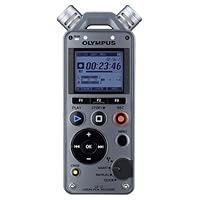 Olympus has become renowned for its high quality digital voice recorders. The LS series represents the higher end of the Olympus line, and a succession of models have been popular because of their compact size, user-friendly controls, and high recording quality. I purchased the LS-12 as a second device to complement my trusty LS-7, which has served me well. This newer model has some very nice features, which perhaps offset the disappointment of its cheaper build quality.
Olympus has become renowned for its high quality digital voice recorders. The LS series represents the higher end of the Olympus line, and a succession of models have been popular because of their compact size, user-friendly controls, and high recording quality. I purchased the LS-12 as a second device to complement my trusty LS-7, which has served me well. This newer model has some very nice features, which perhaps offset the disappointment of its cheaper build quality.The LS-12 is quite a bit larger than the LS-7, but it fits nicely in one's hand and the controls are nicely laid out. Basic recording using the two top-mounted mics is very easy. It's also simple to do record-pause-recording, as many of us do in rehearsal situations where the important material alternates unpredictably with the irrelevant. Manually controlled recording is possible, as well as a handy "Smart Mode" which sets the optimal recording level by responding to an introductory test sample. I confess I have found this feature more useful than I had originally anticipated. The device uses regular SD/SDHC cards, which renders its relatively small 2GB of internal memory not that important.
Another feature of the LS-12 that the LS-7 lacks is a partial-erase mode. This makes punch-in type recording possible, though mastering the steps needed to do this smoothly takes some patience. The LS-12 also has an overdub feature, which can come in handy when one wishes to record say, a vocal track over an instrumental track, or if one wishes to double-track one's own voice. Also included are two levels of low-cut filter and a prerecording function.
Most importantly, the recording quality of the LS-12 seems very good. The quality levels go all the way up to 24-bit 96 khz., which is impressive, and higher than I generally need. Even though it lacks a central mic, I have noticed no falloff in overall quality from the LS-7 (for some kinds of recording the lack of an omnidirectional central mic might be important, however).
I really like the LS-12 for its features and user-friendliness. But there is a (slight) downside. The build quality seems cheap compared with previous Olympus recorders in the LS line. I don't plan on dropping the device on a hard floor, but I do fear for its long-term durability. The other negative is that the instruction manual provided is bare-bones, to put it mildly. Previous recorders came with complete manuals that explained all features in detail. This manual barely covers the basics. Of course, if one has used such a device before it's not that hard to figure things out--as they say, it ain't rocket science. But I found that I had to go through more trial-and-error to master the device than should have been necessary. I am guessing that Olympus is trying to cut costs here and has justified the scaling down of instructions by pointing out that many (most?) people are averse to reading instruction manuals anyway.
Olympus has also eschewed inclusion of its Olympus Sonority software, which had been packaged with previous models. This is not a great loss, but it indicates again an apparent desire to cut costs in some areas.
The final (small) complaint is that there is no carrying case of any kind, nor is there even an option to buy one as an accessory. With exposed mics and a fairly flimsy physical build, the LS-12 really needs protection of some type. Buyers will either have to find a compact camera case of appropriate size, or else one can try to see whether a case built for the previous LS-10 and LS-11 models (of similar, but not identical dimensions) will work.
Overall, the LS-12 (along with its the more expensive LS-14) represents advancement from previous models, but the smart new features apparently have come at the cost of some durability.

No comments:
Post a Comment